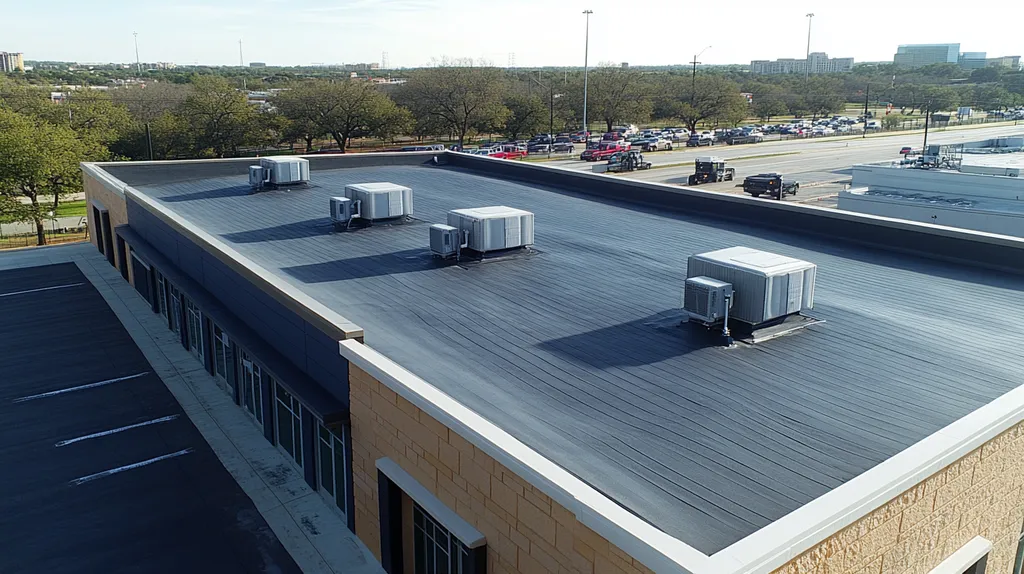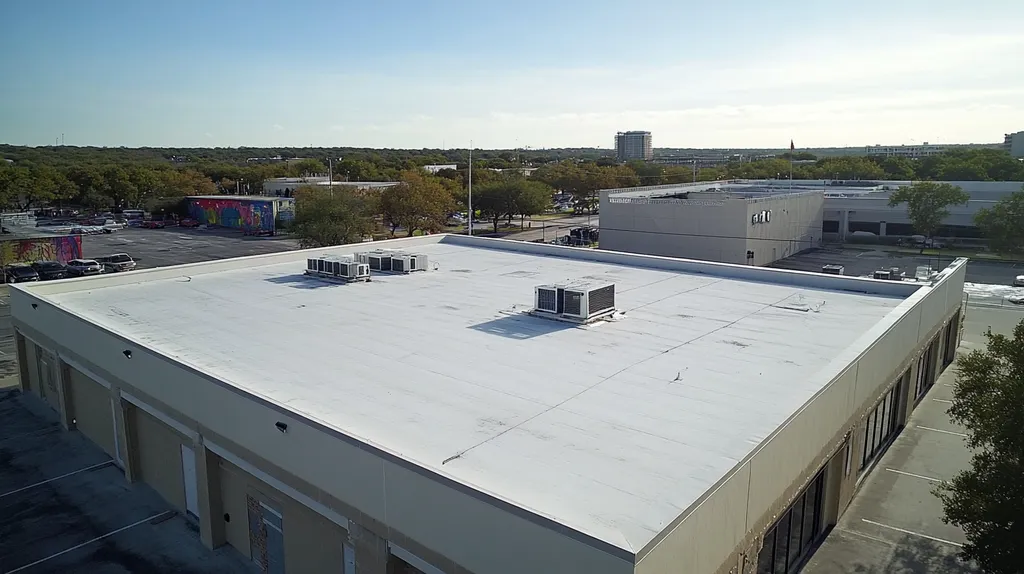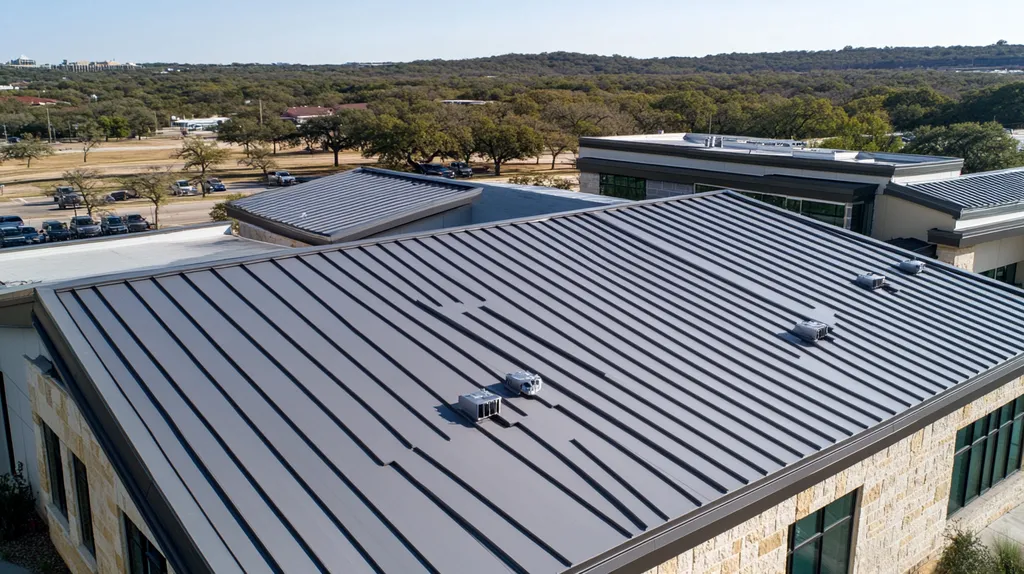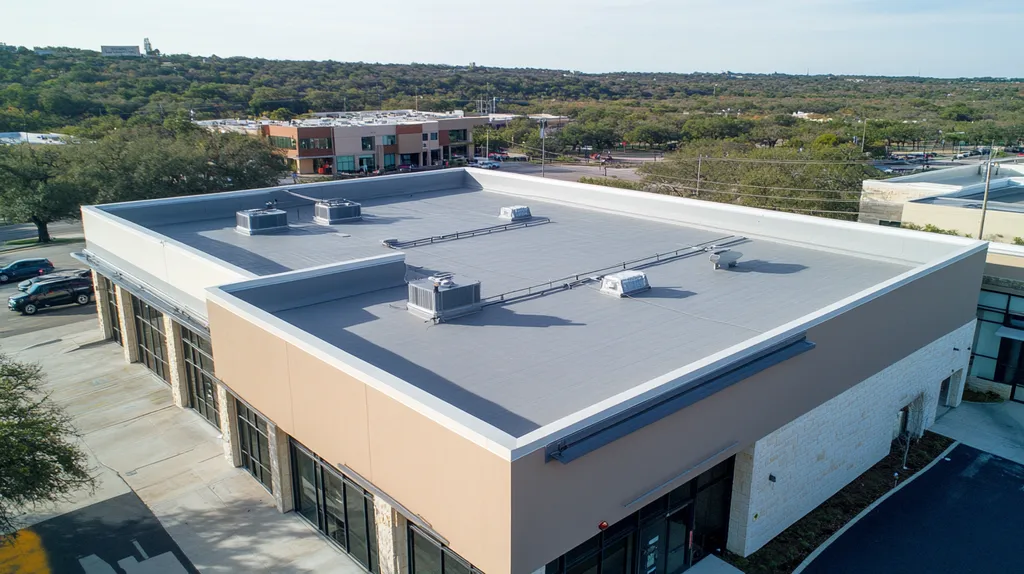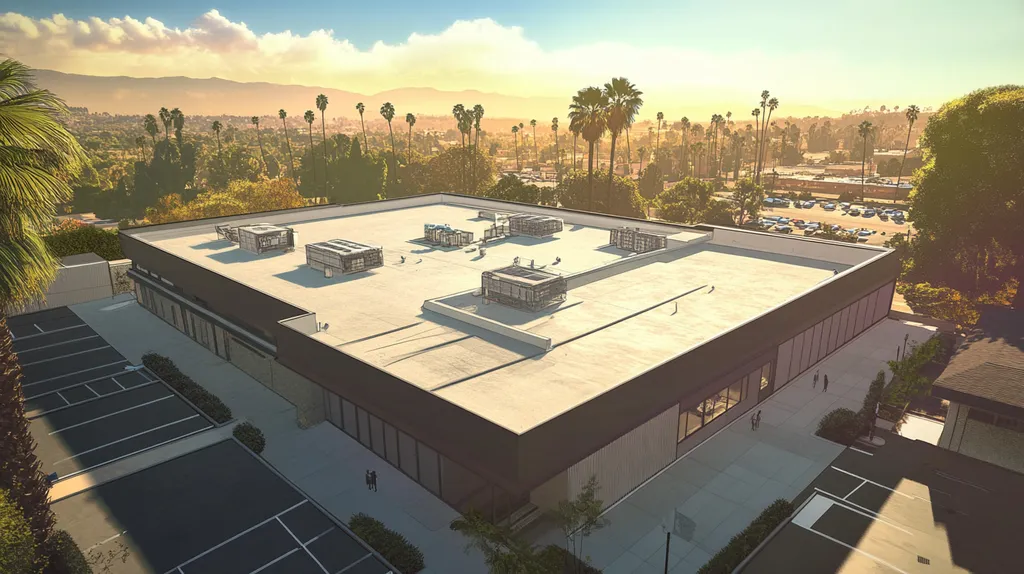Commercial buildings waste millions of dollars annually through uncoated roofs that absorb massive heat, driving up energy costs while pumping unnecessary emissions into the atmosphere.
Meanwhile, facility managers face mounting pressure to slash operating expenses and meet sustainability targets simultaneously.
Roof coatings offer a proven solution that tackles both challenges – dramatically reducing energy consumption while extending roof life and cutting environmental impact.
Understanding how these protective systems work, when to apply them, and what results to expect can transform your building’s environmental footprint while delivering substantial cost savings.
SECTION 1: THE BASICS EXPLAINED
Think of your commercial roof like a giant sponge sitting under a magnifying glass all day long. Without protection, it soaks up heat, UV rays, and weather damage that drives up your energy bills and shortens its lifespan.
Meanwhile, facility managers are facing mounting pressure to cut operating costs while meeting sustainability goals. The good news is that roof coatings offer a straightforward solution that tackles both challenges at once.
What It Is (In Plain Language)
Roof coatings are like sunscreen for your building – but way tougher. These liquid-applied materials get rolled or sprayed onto your existing roof, where they cure into a seamless, flexible protective layer.
You’ll find coatings made from different materials like acrylics, silicones, or polyurethanes. Each type brings its own superpowers to the table, whether that’s flexibility, durability, or chemical resistance.
Most coatings come in bright white or light colors that work like a mirror, bouncing sunlight away from your building. This reflective quality is where the real magic happens for energy savings.
Unlike a full roof replacement that rips everything off and starts over, coatings go right over your existing roof. Think of it as giving your roof a protective shield rather than major surgery.
Why It Matters (To Your Building)
Here’s where the numbers get exciting: reflective roof coatings can slash rooftop temperatures by up to 50 degrees. That means your air conditioning system doesn’t have to work nearly as hard during those blazing summer months.
By lowering air-conditioning demand, these coatings can decrease the associated air pollution and greenhouse gas emissions from conventional power sources (source: United States Environmental Protection Agency). Your utility bills shrink while your sustainability credentials grow.
Beyond energy savings, coatings act like a suit of armor against UV rays, moisture, and the constant expand-and-contract cycle that cracks roofs. This protection can add 10-20 years to your roof’s life.
For facility managers juggling tight budgets, coatings deliver a double win: immediate energy savings and delayed replacement costs. That’s money you can invest in other building improvements.
How It Works
Picture wrapping your entire roof in a protective blanket that never comes loose or develops gaps. That’s essentially what coatings do – they form one continuous film that seals small cracks and prevents water from sneaking in.
The reflective surface works like a car windshield sunshade, bouncing heat away before it can soak into your building. Less heat absorption means cooler interior temperatures and lower cooling costs.
Many coatings have elastomeric properties, which is a fancy way of saying they stretch like a rubber band without breaking. When your roof expands and contracts with temperature changes, the coating moves right along with it.
The application process starts with thorough cleaning and prep work – kind of like washing and sanding before you paint a house. This ensures the coating bonds properly and delivers years of reliable protection.
SECTION 2: PRACTICAL APPLICATIONS
Right now, thousands of commercial buildings are throwing money out the window – literally. Their uncoated roofs are soaking up heat like giant solar collectors, forcing HVAC systems to work overtime and pumping unnecessary emissions into the atmosphere.
The frustrating part? Most facility managers don’t realize how much energy waste is happening right above their heads. A single uncoated warehouse roof can add thousands to annual cooling costs while contributing tons of avoidable carbon emissions.
Common Uses & Examples
Think of roof coatings as the Swiss Army knife of commercial roofing – they work on almost everything. Whether you’re managing a flat EPDM roof on a retail center or a metal roof on a manufacturing plant, there’s likely a coating solution that fits.
Warehouses and distribution centers are coating goldmines because of their massive roof areas. Picture a 100,000-square-foot Amazon facility – coating that roof is like installing a giant mirror that bounces heat away instead of baking everything underneath.
Retail spaces see dramatic results too, especially big-box stores with those sprawling rooftops. When a coating drops roof temperatures by 50 degrees, shoppers stay more comfortable and energy bills plummet during peak summer months.
Manufacturing facilities get double benefits – lower cooling costs and extended roof life. That means less downtime for roof repairs and more predictable maintenance budgets.
The key is matching coating type to your specific situation. Acrylic coatings excel in moderate climates, while silicone coatings laugh off ponding water that would make other materials nervous.
When You Need It Most
Timing is everything with roof coatings – catch your roof at the right moment and you’ll maximize both savings and lifespan. The sweet spot is usually when your roof is showing its age but hasn’t crossed into major damage territory.
If your roof is 5-15 years old and starting to look weathered, you’re in the perfect window. It’s like getting a tune-up for your car before the engine starts knocking – much cheaper than waiting for a breakdown.
Buildings in sun-baked climates like Arizona or Texas should prioritize coatings immediately. Every summer without protection means higher energy bills and faster roof deterioration.
High-energy-cost areas make coatings even more attractive. When electricity rates are sky-high, every degree of cooling you can avoid translates to serious monthly savings.
Emergency situations work too – when you need to buy time before a major roof replacement. A quality coating can give you 10-15 more years while you plan and budget for the inevitable.
Interactions With Other Systems
Your roof doesn’t work alone – it’s the quarterback of a whole team that includes HVAC, insulation, and drainage systems. When coatings reduce rooftop heat, your air conditioning gets to take a breather instead of running at full blast.
Think of it like this: every degree you keep off your roof is one less degree your HVAC has to fight. Cooler roofs mean smaller, more efficient HVAC systems and lower energy consumption across the board.
Insulation becomes more effective too when there’s less heat trying to penetrate from above. It’s like wearing a hat in the sun – your sunscreen (insulation) works better when there’s less direct heat hitting it.
Drainage systems get a boost because quality coatings seal up small cracks and gaps where water loves to sneak in. Less water infiltration means fewer leaks, less mold risk, and healthier indoor air quality.
The trick is making sure all these systems play nicely together. A coating that traps moisture against your insulation can cause bigger problems than it solves, so professional evaluation is crucial.
SECTION 3: KEY TERMINOLOGY DECODED
Every week, facility managers miss out on massive environmental benefits because they get lost in the technical maze of roof coating terminology. When you can’t decode terms like “solar reflectance” or “emissivity,” you might choose a coating that looks good on paper but delivers disappointing real-world performance.
The coating industry loves its jargon, but understanding these key terms is the difference between selecting a coating that actually reduces your building’s environmental impact and one that just sounds impressive in marketing materials. Let’s cut through the confusion and translate what really matters.
Essential Terms Explained
Solar reflectance is your coating’s superpower for bouncing sunlight away from your building. Think of it like a mirror’s effectiveness – higher reflectance means more heat gets reflected back to space instead of cooking your roof and driving up cooling costs.
Emissivity measures how well your coating releases the heat it does absorb, kind of like how quickly a hot pan cools down after you turn off the stove. High emissivity means your roof sheds heat faster once the sun goes down, keeping your building cooler overnight.
Albedo combines both reflectance and emissivity into one number that shows your coating’s total cooling power. It’s like a report card grade for how well your roof fights heat – the higher the albedo, the cooler your building stays.
VOCs (Volatile Organic Compounds) are the nasty chemicals in some coatings that evaporate into the air and create smog. Low-VOC or zero-VOC coatings keep your air cleaner while still protecting your roof – it’s like choosing the eco-friendly cleaning product that actually works.
Industry Jargon Translated
When contractors talk about “cool roofing,” they mean coatings specifically engineered to reflect more sunlight and emit heat better than standard materials. A clean white roof that reflects 80% of sunlight will stay about 55°F cooler than a gray roof that reflects only 20% of sunlight (source: Roof Coatings Association).
Elastomeric coatings are like the yoga instructors of the roofing world – they stretch and flex with your roof’s natural movement without cracking or tearing. This flexibility prevents leaks and extends coating life, reducing the environmental waste of premature replacements.
The layer system – primer, base coat, and topcoat – works like getting dressed for winter. The primer is your base layer that bonds to the roof, the base coat is your insulating sweater that provides thickness and protection, and the topcoat is your weatherproof jacket that faces the elements.
Urban heat island effect describes how cities get hotter than surrounding rural areas because of all the dark, heat-absorbing surfaces. Your coated roof helps fight this by reflecting heat instead of storing it, making your whole neighborhood more comfortable.
Measurement & Units Simplified
Solar reflectance gets measured on a scale from 0 to 1, where 1 means perfect reflection (like a mirror) and 0 means total absorption (like black asphalt). A coating with 0.70 reflectance bounces back 70% of the sun’s energy – that’s pretty impressive performance.
Emissivity uses the same 0 to 1 scale, where 1 means perfect heat release. Most effective environmental coatings score above 0.85 on emissivity, meaning they’re excellent at shedding the heat they do absorb.
Coating thickness gets measured in “mils,” which sounds fancy but just means thousandths of an inch. A 20-mil coating is 20/1000 of an inch thick – about as thick as a heavy garbage bag but way more durable.
Energy savings often get reported in kilowatt-hours (kWh) saved per year, which translates directly to lower electricity bills and reduced power plant emissions. These numbers help you calculate both your environmental impact and return on investment from coating projects.
SECTION 4: DECISION FACTORS
Every month, facility managers make coating decisions that will impact their buildings for the next 10-20 years. Choose poorly, and you’re stuck with skyrocketing energy bills, frequent repairs, and a coating that fails just when you need it most.
The problem is that coating selection often comes down to whoever has the lowest bid or the flashiest marketing materials. Meanwhile, the factors that actually determine long-term environmental benefits and cost savings get overlooked in the rush to make a decision.
Cost Considerations
Here’s the trap most facility managers fall into: they see a coating bid for $2 per square foot versus $4 per square foot and automatically pick the cheaper option. What they don’t realize is that the “expensive” coating might pay for itself within three years through energy savings alone.
Think of it like buying tires for a delivery truck – cheap tires might cost half as much upfront, but they’ll need replacing twice as often and hurt your fuel economy the whole time. Quality roof coatings work the same way, delivering energy savings that compound year after year.
Installation costs can swing wildly based on your roof’s condition and accessibility. A coating that goes on easily over your existing membrane will cost far less to install than one requiring extensive surface prep or multiple application trips.
Don’t forget about rebates and incentives – many utility companies and local governments offer cash back for energy-efficient coatings. These programs can knock 20-30% off your total project cost while boosting your sustainability credentials.
Smart budgeting looks at the total cost of ownership over 15-20 years, not just the upfront price tag. A coating that cuts your cooling costs by $10,000 annually quickly makes up for a higher initial investment.
Performance Trade-offs
Every coating is like a superhero with specific powers and weaknesses – acrylic coatings excel at UV reflection but get nervous around standing water, while silicone coatings laugh off ponding conditions but cost more upfront. The trick is matching your coating’s superpowers to your roof’s biggest challenges.
Climate drives everything in coating performance. A coating that works beautifully in dry Phoenix heat might fail miserably in humid Houston conditions, where moisture and temperature swings create different stress patterns.
Reflective roof coatings can keep roofs up to 55°F cooler than traditional roofing materials, dramatically reducing energy use and greenhouse gas emissions (source: Roof Coatings Manufacturers Association). But that same reflectivity might be overkill in northern climates where winter heating costs matter more than summer cooling.
Your building’s daily routine matters too – a warehouse with constant forklift traffic needs a coating that can handle mechanical abuse, while a quiet office building can prioritize maximum reflectivity over durability.
The best coating balances multiple performance factors rather than maximizing just one. It’s like choosing a Swiss Army knife over a single-blade knife – you want the tool that handles your most common challenges effectively.
Lifespan & Durability Factors
Here’s where environmental impact gets real: a coating that lasts 5 years creates four times as much waste as one that lasts 20 years. Every time you strip and recoat, you’re generating disposal waste, using new materials, and burning fuel for equipment and transportation.
Durability isn’t just about the coating material – it’s about how well that material handles your specific roof conditions. UV exposure, temperature cycling, and mechanical stress all chip away at coating life in different ways.
Premium coatings with elastomeric properties stretch and flex with your roof’s natural movement, preventing the micro-cracks that let water sneak in and start the deterioration process. Think of them as athletic wear for your roof – they move without breaking.
Maintenance planning extends coating life dramatically and protects your environmental investment. Regular inspections catch small problems before they become coating-killing disasters, while simple cleaning keeps reflective surfaces working at peak efficiency.
The most durable coatings often deliver the best environmental bang for your buck by avoiding premature tear-offs and reducing the frequency of recoating projects. They’re the marathon runners of the roofing world – built to go the distance while performing consistently.
SECTION 5: COMMON CHALLENGES
Every year, millions of square feet of roof coatings fail prematurely, creating unnecessary waste and destroying environmental benefits that should have lasted decades. These failures rarely happen overnight – they start with small, preventable problems that snowball into coating disasters.
The frustrating part is that most coating failures stem from the same handful of mistakes that keep happening across the industry. When facility managers know what to watch for and how to prevent these issues, their coatings deliver the full environmental impact they paid for.
Frequent Problems & Solutions
Poor surface preparation tops the list of coating killers, and it’s completely avoidable with proper planning. Think of it like painting over rust – no matter how good your paint is, it won’t stick to a dirty, unprepared surface.
Moisture trapped under coatings creates bubbles and blistering that destroy both appearance and performance. This happens when contractors rush the job and apply coatings over wet surfaces or skip the proper drying time between coats.
Wrong coating selection for your specific roof type is like wearing flip-flops to climb a mountain – it might work briefly, but failure is inevitable. Acrylic coatings over ponding water areas or silicone over incompatible substrates lead to premature peeling and delamination.
The solution starts with thorough roof cleaning and inspection before any coating touches your roof. Professional contractors should pressure wash, remove all loose material, and ensure complete dryness before application.
Matching coating chemistry to your roof material and local climate conditions prevents most compatibility issues. When in doubt, test patches in inconspicuous areas help verify adhesion and performance before coating the entire roof.
Quality control during application – checking film thickness, weather conditions, and cure times – catches problems while they’re still fixable rather than after they’ve destroyed your environmental investment.
Warning Signs To Watch For
Smart facility managers become coating detectives, spotting the early clues that signal trouble before minor issues become major failures. The key is knowing what normal aging looks like versus signs of serious problems.
Discoloration, chalking, and areas of reduced reflectivity indicate the coating may be losing its effectiveness and could allow moisture infiltration, according to industry research. These visual changes often mean your energy-saving reflective properties are disappearing (source: Roof Coatings Manufacturers Association).
Cracking, blistering, or peeling sections create pathways for water infiltration that can damage your roof deck and insulation. These problems typically start small but spread quickly once moisture gets underneath the coating film.
Ponding water that doesn’t drain within 48 hours after rainfall can overwhelm even the best coatings over time. This standing water accelerates coating breakdown and creates perfect conditions for leaks to develop.
Interior signs like water stains, temperature fluctuations, or higher energy bills often indicate coating failure from the inside out. By the time you see these symptoms, the coating has likely lost much of its protective and energy-saving capability.
Regular roof walks after storms help catch damage while it’s still manageable. What looks like minor coating wear from ground level might reveal serious adhesion problems that need immediate attention.
Preventative Approaches
The best coating challenges are the ones that never happen, which means building prevention into every step from initial planning through ongoing maintenance. Think of it like preventative medicine for your roof – much cheaper and more effective than emergency treatment.
Professional installation using certified contractors eliminates most application-related failures before they start. Experienced applicators know how to read weather conditions, prepare surfaces properly, and apply coatings at the right thickness for maximum durability.
Scheduled maintenance programs catch small problems while they’re still small, extending coating life and preserving environmental benefits. Simple tasks like cleaning drains, removing debris, and washing reflective surfaces keep coatings performing at peak efficiency.
Documentation systems that track application dates, weather conditions, and maintenance activities help predict when coatings might need attention. This data-driven approach prevents surprise failures and helps plan coating renewals during optimal weather windows.
Quality material selection from reputable manufacturers with strong warranty programs provides backup protection when unexpected problems arise. The slight extra cost of premium coatings often pays for itself through longer life and better performance.
Building relationships with knowledgeable roofing professionals creates a support network for ongoing coating success. Regular inspections and maintenance guidance from experts help maximize both environmental benefits and return on investment.
SECTION 6: NEXT STEPS & RESOURCES
Right now, thousands of facility managers are sitting on goldmines of environmental savings but don’t know which questions to ask or where to find reliable guidance. The wrong contractor can waste years of potential energy savings, while outdated standards might leave you with a coating that looked good in 2015 but fails today’s sustainability requirements.
The coating industry moves fast, with new technologies and stricter environmental standards emerging every year. Without the right roadmap for vetting providers and staying current on best practices, you risk choosing solutions that deliver disappointing results when your building needs maximum environmental impact.
Questions To Ask Providers
The difference between a coating that transforms your building’s environmental impact and one that barely makes a dent often comes down to five critical questions. Start by asking for specific solar reflectance and thermal emittance numbers – not marketing claims, but actual CRRC-rated performance data that shows exactly how much heat your coating will reject.
Demand to see VOC levels and environmental certifications, especially if you’re in areas with strict air quality regulations. Low-VOC coatings aren’t just better for the planet – they often indicate higher-quality formulations that last longer and perform better.
Ask about warranty coverage and what it actually includes – some warranties sound impressive but exclude the most common failure modes. A contractor confident in their environmental claims will gladly provide detailed performance guarantees and maintenance recommendations.
Question their installation process and timeline, particularly how they handle weather delays and surface preparation. Rushed jobs that skip proper prep work are environmental disasters waiting to happen, no matter how good the coating material looks on paper.
Finally, request references from similar buildings in your climate zone and ask to see actual energy bill comparisons. Real-world performance data tells you more than any marketing brochure about whether this coating will deliver the environmental benefits you’re paying for.
Industry Standards & Guidelines
Think of industry standards as your insurance policy against environmental disappointment – they separate legitimate high-performance coatings from products that just sound impressive in sales presentations. The Cool Roof Rating Council (CRRC) provides the gold standard for measuring solar reflectance and thermal emittance, giving you apples-to-apples comparisons between different coating options.
ENERGY STAR and LEED programs reference specific performance thresholds that translate directly into measurable environmental benefits. Coatings that meet these standards have been independently tested and verified to deliver the energy savings they promise.
ASTM and NRCA guidelines spell out proper installation procedures that protect your environmental investment. A coating applied according to these standards will perform as designed, while shortcuts and non-standard practices often lead to premature failure and wasted sustainability efforts.
Local building codes increasingly mandate minimum reflectance values for commercial roofs, especially in hot climates where cooling energy dominates building consumption. Staying ahead of these requirements protects you from costly retrofits when regulations tighten.
Cool roofs reflect more sunlight and absorb less heat compared to traditional roofing materials, with surface temperatures up to 55°F cooler that help reduce energy demands and greenhouse gas emissions (source: RoofCoatings.org). Following established standards ensures you capture these maximum environmental benefits rather than settling for mediocre performance.
Further Learning Simplified
The roofing industry evolves faster than most facility managers can keep up with, but focusing on a few trusted sources keeps you informed without information overload. The Department of Energy’s Building Technologies Office publishes case studies that show real-world results from coating projects, complete with energy savings data and lessons learned.
Professional organizations like NRCA and the Roof Coatings Manufacturers Association offer webinars and white papers that translate complex research into practical guidance. These resources help you understand emerging technologies and changing regulations before they impact your building.
Trade publications and industry conferences provide networking opportunities with other facility managers facing similar environmental challenges. Learning from peers who’ve successfully implemented coating programs saves you from repeating their mistakes while identifying new opportunities.
Manufacturer technical bulletins and application guides offer detailed specifications and troubleshooting advice for specific products. While these sources have obvious bias, they contain valuable technical information about proper installation and maintenance practices.
Local utility company resources often include rebate programs, energy auditing services, and educational materials tailored to your specific climate and energy costs. These programs can significantly offset coating costs while providing ongoing support for maximizing environmental benefits.
The Bottom Line
Commercial buildings across America are hemorrhaging millions in energy costs while pumping unnecessary emissions into the atmosphere – all because facility managers delay coating decisions that could transform their environmental impact within months.
The math is undeniable: reflective roof coatings can slash rooftop temperatures by 50 degrees, cut cooling costs by 10-40%, and extend roof life by decades. Every month without protection means higher utility bills and accelerated roof deterioration.
The coating technology exists today to dramatically reduce your building’s environmental footprint while delivering substantial cost savings. The question isn’t whether coatings work – it’s whether you’ll implement them before your next energy bill arrives.
Your roof represents either your biggest energy waste or your greatest sustainability opportunity. The choice, and the urgency, is entirely yours.
FREQUENTLY ASKED QUESTIONS
Q. What exactly are commercial roof coatings and how do they work?
A. Think of coatings as sunscreen for your building, forming a tough, reflective layer over your roof. This layer bounces sunlight away, keeping the building cooler and saving energy while protecting the roof from wear and tear that would reduce its lifespan.
Q. Which commercial roof types benefit most from coatings?
A. Almost any flat or low-slope roof, like on warehouses, retail stores, or manufacturing plants, can benefit from coatings. These roofs act like giant heat collectors, so coatings reduce cooling needs and extend roof life, especially in hot climates or buildings with large rooftop areas.
Q. What key terms should I understand about commercial roof coatings?
A. Terms like solar reflectance describe how well a coating bounces sunlight away, while emissivity shows how quickly it sheds heat after dark. Knowing these helps you pick coatings that really cool your building instead of just sounding good in marketing.
Q. What factors should I consider when choosing a commercial roof coating?
A. Cost is important, but a cheaper coating can cost more long-term if it fails early or saves less energy. Match the coating’s strengths to your roof’s conditions and climate, and think about lifespan and maintenance to get the best environmental and financial value.
Q. What common problems cause commercial roof coating failures?
A. Most failures come from poor surface prep, trapped moisture, wrong coating for the roof, or rushed application. Preventing these with professional cleaning, inspection, and proper product choice ensures your coating lasts long and performs as promised.
Q. What questions should I ask a contractor before coating my industrial roof?
A. Request real solar reflectance and thermal emittance data, check for low VOC levels, understand warranty details, verify their installation and prep processes, and ask for references from similar buildings to ensure you hire a qualified installer who delivers real results.
Q. How do roof coatings help reduce my building’s carbon footprint?
A. By reflecting sunlight and lowering rooftop temperatures, coatings reduce the energy your air conditioning system uses, cutting down on emissions from power plants. This simple change turns your roof into part of the solution in fighting climate change while saving money.

